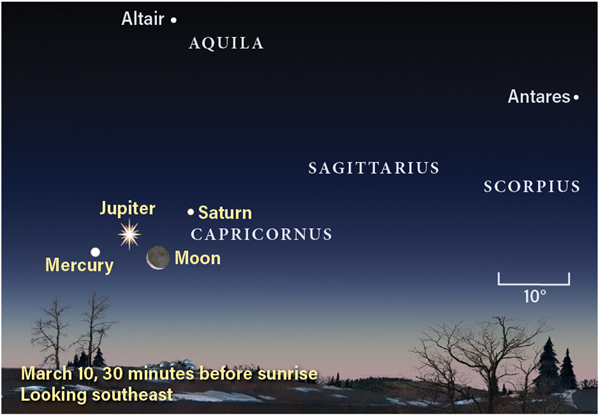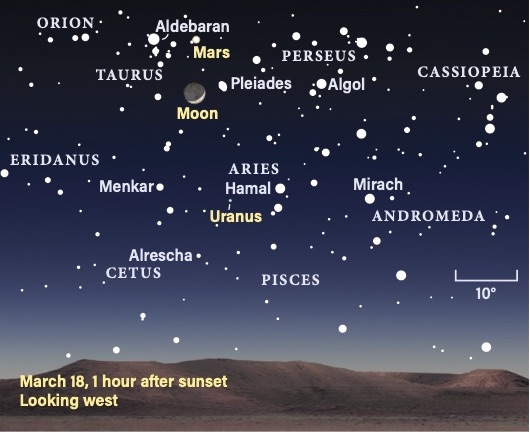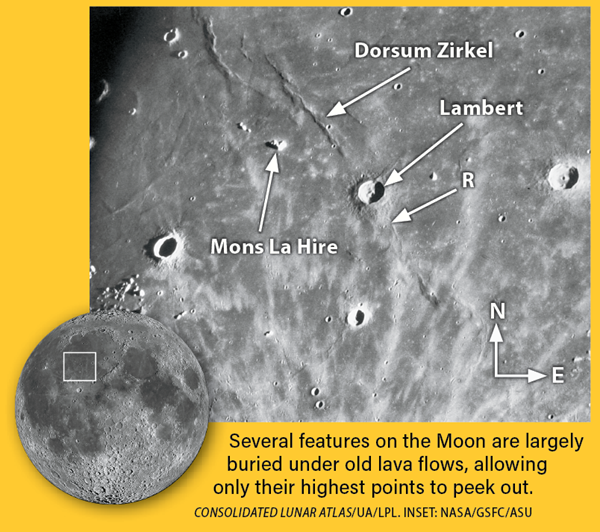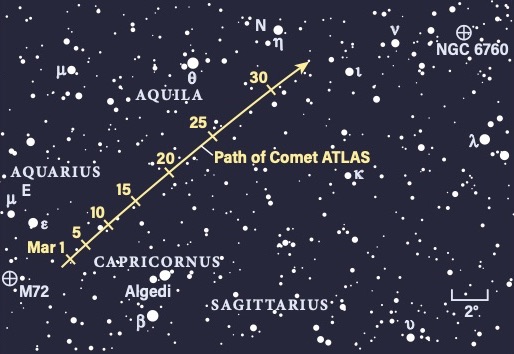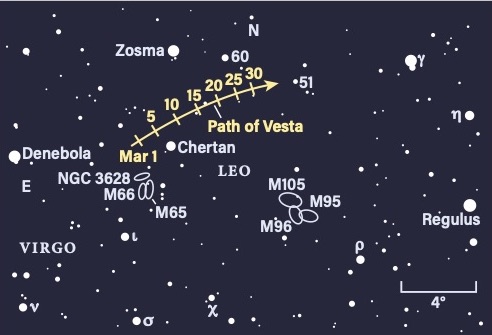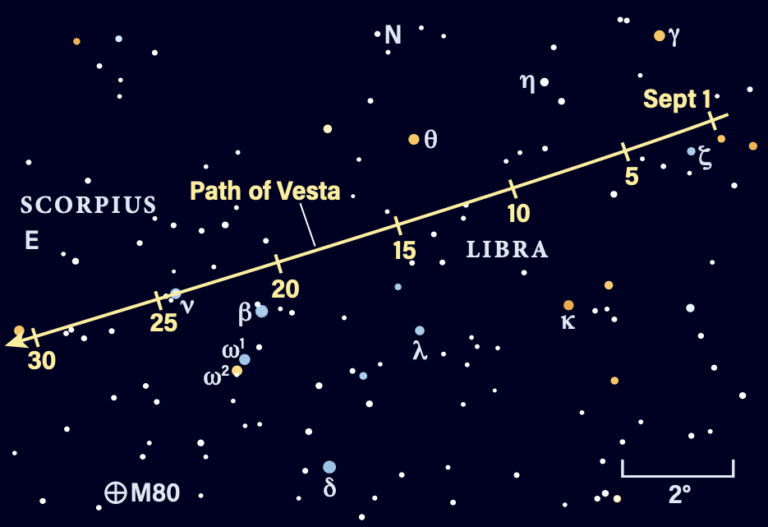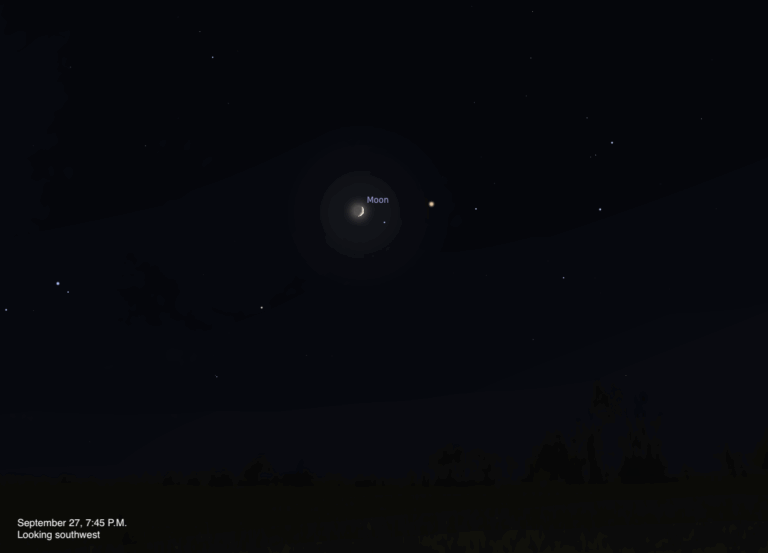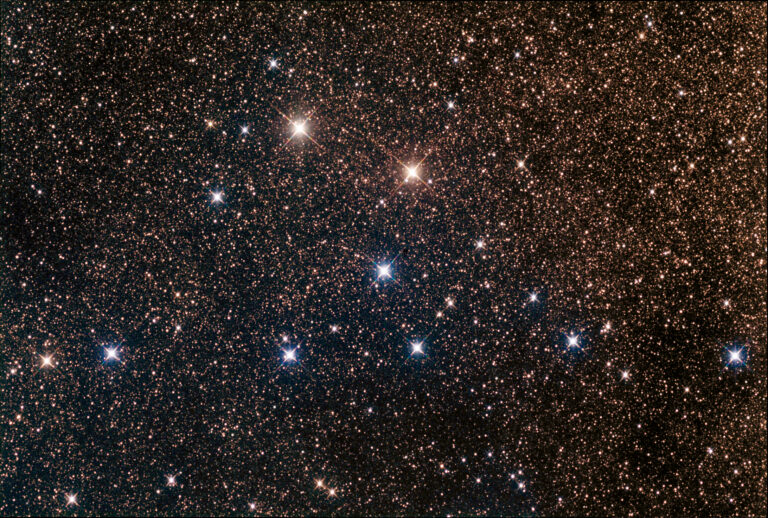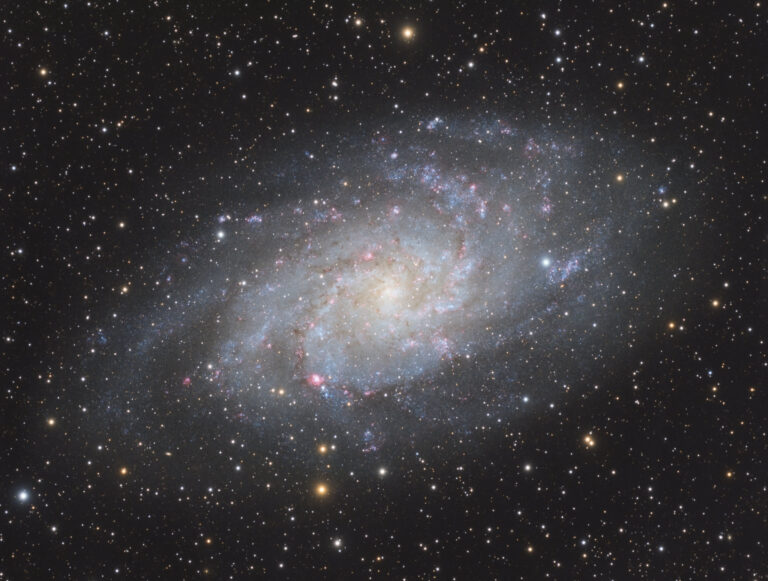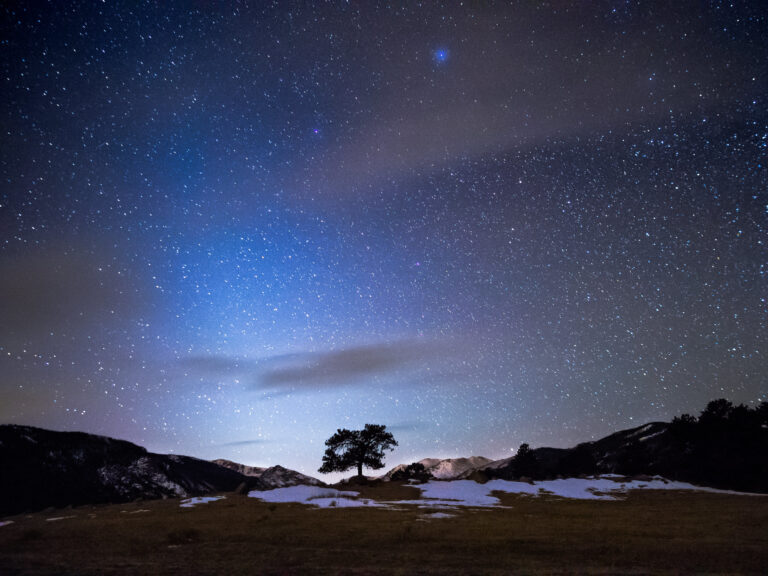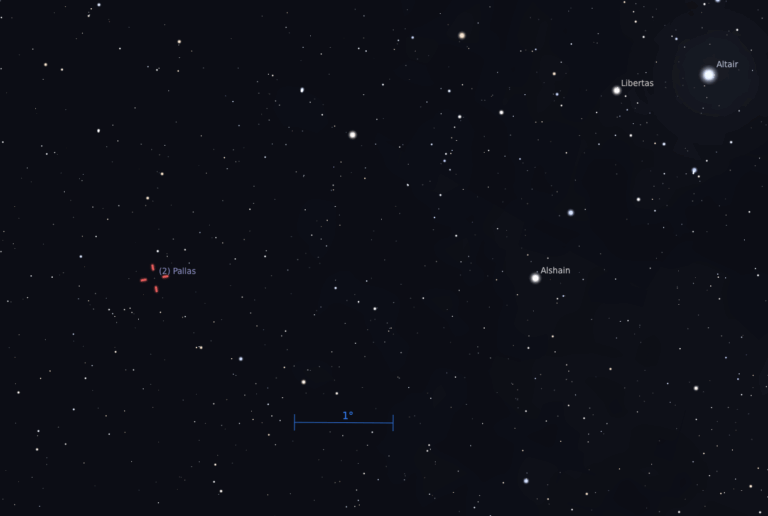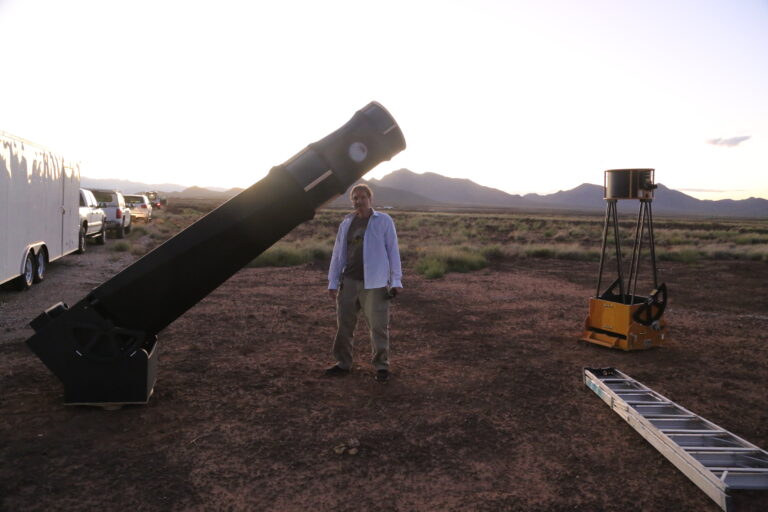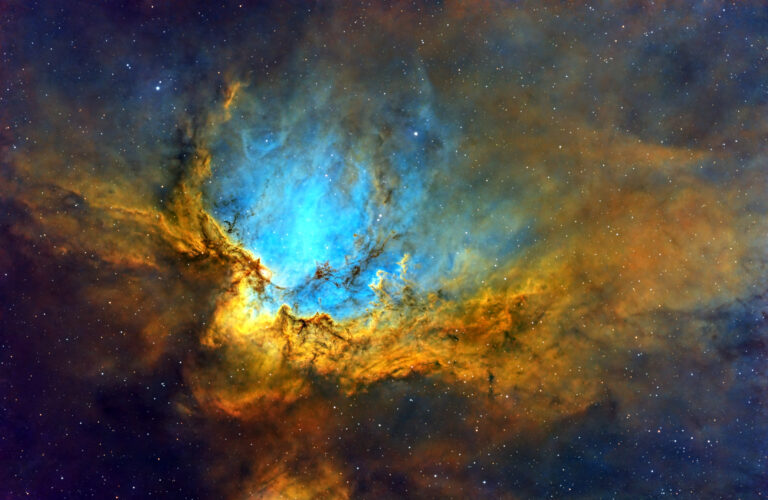Key Takeaways:
Mars is a dramatic and bright addition to Taurus; it is the first planet to come into view after sunset. The Bull now hosts two objects of first magnitude: the fine red giant star Aldebaran (magnitude 0.8) and Mars, which fades from magnitude 0.9 to 1.3 during March. As March opens, the Red Planet is beautifully situated near the Pleiades (M45).
Mars stands about 3° due south of M45 on March 1, and remains in the vicinity for a few days as it drifts slowly eastward. The planet cruises north of the Hyades star cluster during the third week of the month. A lovely crescent Moon joins in on March 18 and 19. On the 18th, the Moon is 5° from M45 and Mars stands 8° northeast of our satellite. The following evening, Mars stands less than 4° west of the Moon, forming a nice triangle with Aldebaran to the south.
The Red Planet continues eastward, passing 7° due north of Aldebaran on March 22. By the 31st, it stands near the sparse star cluster NGC 1746 — a nice object when viewed in binoculars, made all the more striking with Mars glowing nearby at magnitude 1.3.
Mars is a tiny object in telescopes, spanning 6″ as March opens and shrinking by 1″ by the end of the month. At this apparent size, Mars is heavily affected by turbulence in our atmosphere. Even at an elevation above 50° soon after dusk, its features are challenging without a large telescope. Observers who have developed their skills with video imaging may give it a try, but it truly is the luck of the draw when it comes to the seeing conditions that will govern the results you might achieve.
Since Uranus lies in a sparse region of the sky, another useful visual guide is to drop directly below the Pleiades until you’re level with Hamal and begin your binocular search there, scanning just below the line connecting Hamal with the 3rd-magnitude star Menkar (Alpha [α] Ceti) in Cetus the Whale. In 7×50 binoculars, you’ll find a line of three stars close to 6th magnitude and spanning 5° — these are 27, 29 and 31 Arietis. Uranus is the brightest object below the middle star (29 Arietis).
Late evenings in March are devoid of bright planets. However, the middle of the night is a great time to search for minor planets. In particular, 4 Vesta, the brightest asteroid, reaches opposition March 4. Vesta was discovered in neighboring Virgo March 29, 1807, by German astronomer Heinrich Olbers. It was his second discovery, after finding 2 Pallas five years earlier.
Vesta currently lies in the tail section of Leo the Lion. At magnitude 5.8, it’s an easy binocular object, and this spring is your best opportunity to spot this fascinating asteroid. On the 4th, you’ll find Vesta in the same binocular field of view as 3rd-magnitude Chertan (Theta [θ] Leonis). Center the star in binoculars and you’ll easily spot Vesta 1.3° to the northeast. There are no other stars rivaling Vesta in brightness in the area, making it easy to identify.
Vesta’s orbital path carries it northwestward at about 0.25° per day; it stands 1.3° due north of Chertan on March 8. It passes 8′ due south of a 6th-magnitude field star on March 16, then lands 2.1° due east of 51 Leonis on March 31, in the sparsely populated central region of the constellation. Look for the shallow triangle the pair makes with 60 Leonis to the east — both stars and Vesta fit inside the field of view of 7×50 binoculars.
Vesta remains visible all night. Follow it until summer, when the minor planet spends a week in June within 1° of M65 and M66 after reaching its stationary point in April and making an about-face through the constellation.
With each subsequent morning, the three planets briskly change relative positions. Mercury is following the Sun along the ecliptic and lies on the far side of the solar system, moving toward a springtime superior conjunction. Its visibility declines after the middle of March. Jupiter and Saturn are climbing away from their respective conjunctions with the Sun, improving their visibility each day.
Mercury starts the month standing 2.5° west of Jupiter. Its March 11 conjunction with Jupiter takes place in daylight, but the mornings before and after are prime times to view the pair. By March 4, the pair stands 0.6° apart, and the following morning, only 0.4° separates the planets and Mercury has brightened to 0.2. Mercury, the closer of the two at 0.93 astronomical units from Earth, spans 7″ and is 55 percent lit. (One astronomical unit, or AU, is the average Earth-Sun distance.) Jupiter lies more than six times the distance of Mercury from Earth — 5.9 AU — yet spans a much larger 33″.
A slim crescent Moon joins the scene from March 9 to 11. Saturn stands 7.5° northeast of the 26-day-old Moon on the 9th. The following morning, the Moon has glided along the ecliptic and you’ll find Jupiter standing 5° north-northeast of our natural satellite, while Mercury shines 4.5° due east of Jupiter.
By March 14, when daylight saving time takes effect, Saturn is up by 5:20 A.M. local time, followed by Jupiter half an hour later. Mercury lies in much brighter twilight, rising around 6:20 A.M. local time. You have a narrow window to view the innermost planet, now at magnitude 0, before twilight drowns it out. Look for it about 3° high around 6:40 A.M. local time on March 14. You can follow Mercury’s descent into brighter twilight each consecutive morning, although you’ll need a clear eastern horizon to do so.
Saturn and Jupiter become easy objects low in the southeast by the end of March. Both lie in Capricornus the Sea Goat. Saturn rises around 4:20 A.M. local time on March 31, with Jupiter still trailing by about 30 minutes. As twilight begins, both planets lie below 15° altitude, a difficult location for telescopic observations due to poor seeing conditions. They’re now almost 12° apart. Both planets become easier telescopic targets next month.
Neptune reaches superior conjunction with the Sun March 10, and Venus reaches superior conjunction March 26. Neither planet is visible this month.
Rising Moon: The three towers
Even youthful features on the Moon are still old. The great molten floods that filled the giant Imbrium impact basin ended about 1.1 billion years ago. We know that the frenetic inner solar system bombardment had ended before that, otherwise the lava plains would contain as many craters as the other regions.
West of the spectacular flooded crater Archimedes, itself north of the lunar equator, the small impact crater Timocharis stands out atop the flat plain on March 20. Lambert comes into view on the 21st, casting a long shadow into the still-darkened half of our satellite. Look carefully just to its south and you should see the ghostly ring of Lambert R. This circular feature is most likely an old crater buried in lava, whose peaked rim just manages to deform the surface. Its gentle slopes are visible only with a low Sun angle — in a couple of nights, the thin shadows will have disappeared completely.
Standing out in the darkness northwest of Lambert is Mons La Hire, whose isolated peak catches the Sun’s rays a lunar day before its base experiences sunrise. Lunar scientists William Hartmann and Charles Wood proposed in 1971 that La Hire is related to other peaks on the north side of Mare Imbrium, including Piton and Pico. Giant impacts often form multi-ring structures, and the tallest ring is marked by this trio of towers. The rest of the quasicircular chain is buried under the lava, but, like Lambert R, it deforms the surface into ridges. One such ridge segment is Dorsum Zirkel, heading off to the northwest of Lambert. This, too, will disappear from sight under a higher Sun, so don’t wait to find it.
Meteor Watch: Solar system dust
For a second month in a row no major meteor showers occur, although the background sporadic rate provides an average of seven meteors per hour. The main feature this month is the zodiacal light, which enjoys prime viewing time in March because the ecliptic is inclined steeply to the western horizon.
Once the long, low arc of twilight has almost gone from the west, notice the additional glow stretching up through Aries and Taurus. Observers in dark locations — and preferably at higher elevations — are favored with a view of this elusive glow.
The zodiacal light comes from sunlight reflecting off billions of dust particles that pervade the solar system — the remnants of eons of dusty comets ejecting their mass.
Whenever Earth encounters these trails, we see a meteor shower. But in March, we instead see the vast expanse of this dust stretched out across space. Aim for the moonless period of the first two weeks of the month to search out this phenomenon; the last two days of March are also favorable.
Comet Search: A newcomer rises with the dawn
Waking up from its thousand-year sleep, Comet C/2020 R4 (ATLAS) is competing for the top of the telescopic comet list this spring. It’s visiting from the Kuiper Belt, having traveled some four times Pluto’s distance to reach us. The comet was discovered September 12 by the Asteroid Terrestrial-impact Last Alert System search program (also known as ATLAS).
Nicely timed to cap off a long night of deep-sky Messier marathoning midmonth, ATLAS floats in near M72. Your jumping-off point to reach the 9th-magnitude globular cluster is the naked-eye double star Algedi (Alpha1 [α1] and Alpha2 [α2] Capricorni); you may as well first jog northwestward to pick up the slightly fainter comet.
The two objects share a few other characteristics that are best seen at magnifications above 100x. Both should be mostly round, brighter in the middle, and fading quickly to a soft edge. Perhaps in a big scope there will be a hint of green from the ionized gas in the comet’s coma. Boost the power some more to see if you can detect that the southeast flank of the comet is more sharply defined. This is where the solar wind pushes back the dust in a bow wave.
In contrast to ATLAS’ brief passage, amateur astronomers will soon be treated to C/2017 K2 (PanSTARRS)’s two-year-long appearance!
Locating Asteroids: The best rock is back
Suburban binocular tracking has returned! This month, Asteroid 4 Vesta cracks the top 10 brightest lights in all of Leo’s hindquarters. That means experienced observers can step outside without dark adapting, look to the east with binoculars, and identify a space rock in five minutes.
If you’re relatively new to matching charts to the sky and handling binos or a small scope, then slow down and enjoy this easy treasure hunt. The blue-white luminary in this region is Regulus, whose poetic Latin name is Cor Leonis, the heart of the lion. Look to its lower left (northeast) for a triangle of bright stars: Chertan, Zosma, and Denebola. These anchor a sketch — use them as a frame in which to place the other starlike object, Vesta, every other night.
Noticing the 6th-magnitude main-belt asteroid move in one three-hour session is tough, requiring a scope at 150x or so. The best window is from the 13th to the 17th, when Vesta oh-so-slowly oozes between a widely set duo of field stars with magnitudes 6.3 and 6.8.
The fourth body discovered in the main belt, Vesta is roughly 300 miles across, half the size of dwarf planet 1 Ceres. NASA’s Dawn mission orbited Vesta for almost a year from 2011 to 2012, finding evidence supporting the proposal that some meteorites recovered on Earth were long ago blasted off its surface.


